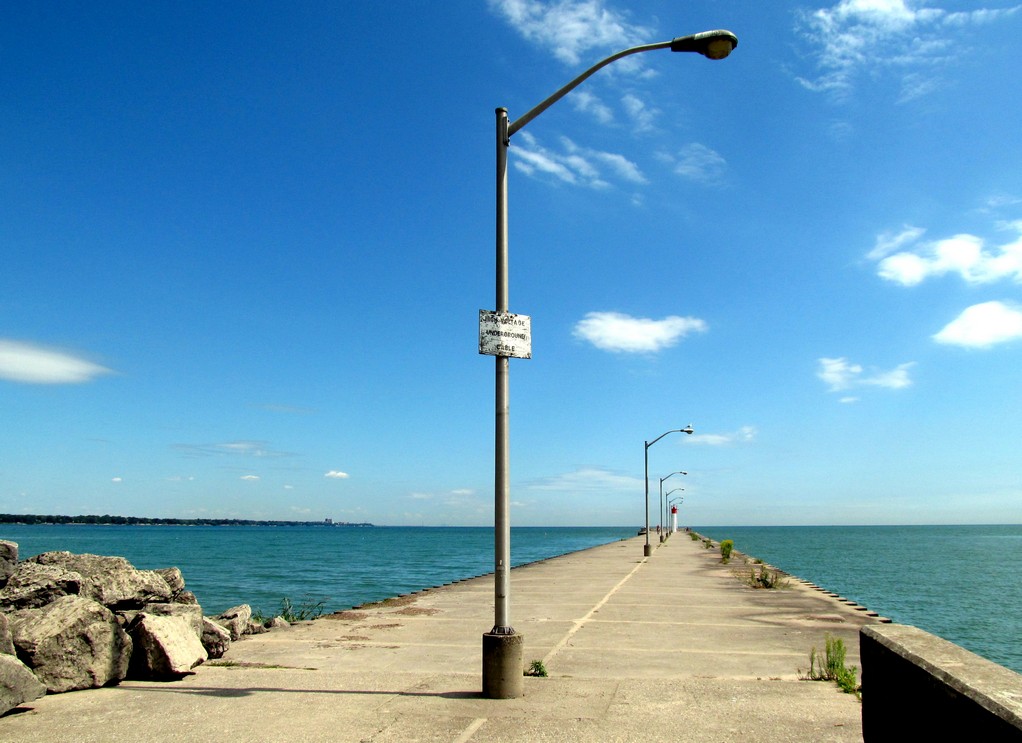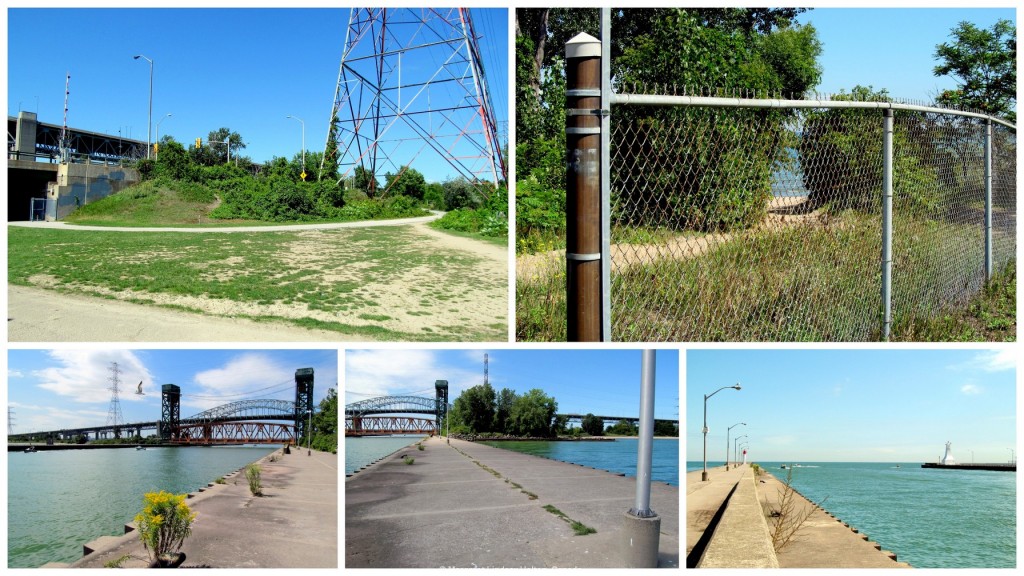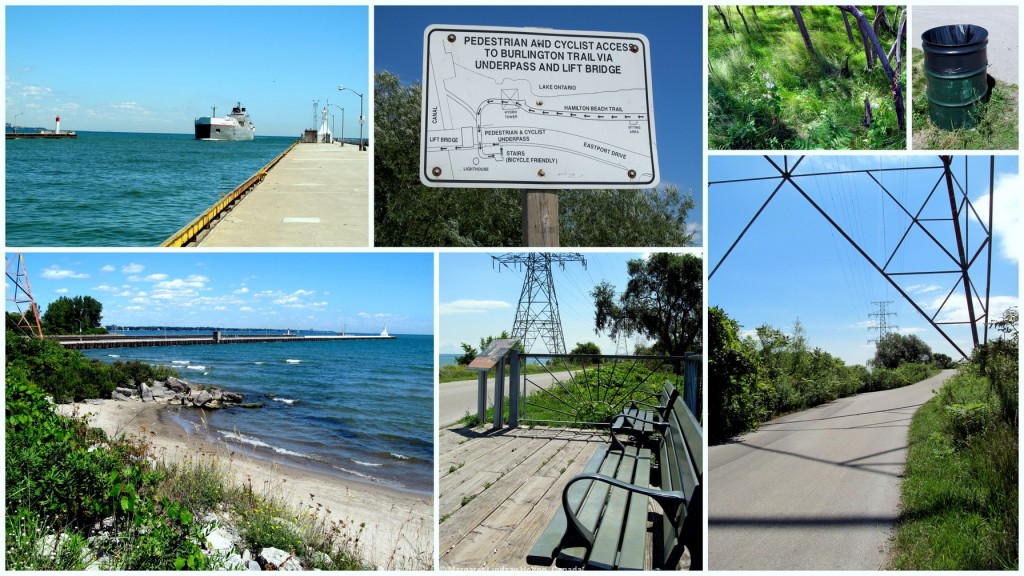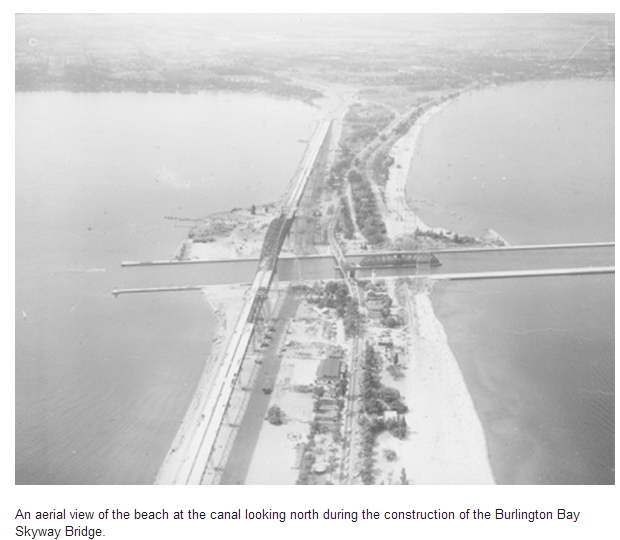BURLINGTON, ON September 4, 2012 I did not know much about this massive concrete pier that juts far out into the lake until very recently. And wow, what a discovery and treat it is. Albeit, ‘as is’, it is sadly neglected and regrettably inhospitable. Where is it? This pier is located on the northern side of the Burlington Canal entrance to the Burlington Lift Bridge, a mere stone’s throw from the downtown core.
There are actually two piers out there – the Burlington Pier and the Hamilton Pier – each one on either side the Burlington canal which is currently part of the boundary between the two cities.

Looking a little forlorn and very unused, the Burlington Canal pier was once a hub of activity with hundreds of people on the pier waiting to board small ships passing through.
Located at the far end of what is known as the Burlington Beach strip, current access is very limited. Parking is forbidden in the nearest cul-de-sac and there is no readily available public-access parking. An overgrown and narrow pathway, (a remnant of the once exulted Waterfront Trail), provides a shabby unwelcoming ‘entrance’. An untended sandy footpath veers off the paved Waterfront Trail, (that continues on under the lift bridge), to the pier.
Once on the pier – aside from truly eye-popping views – dilapidated signage, weeds bursting through surface concrete, no benches, no civilian garbage bins and little care-taking whatsoever, present a grossly overlooked civic and tourism opportunity.

These are some of the views from the pier that Burlington already has. Well worth the walk to see the city from this vantage point.
Compared to the Hamilton side of the canal, Burlington’s forgotten pier is a bit of a civic embarrassment. Hamilton’s side has clean current signage, a wider (and tidier) beach boardwalk that has convenient sturdy bench parkettes accented by historical signposts about the development of the Burlington Canal. Ample public paved parking is available beside the pier pathway. Civilian garbage bins are emptied regularly. Attractive sand grasses and natural indigenous lake vegetation grow in profusion. The area is frequented by walkers, bikers, runners, roller-bladders, birders and driving tourists. All in all, Hamilton’s side of the Burlington Canal is much more alluring then the Burlington side.

A collage of pictures showing the state of the Hamilton pier on the west side of the Burlington Canal
Both sides could upgrade their pier lamps (and maybe incorporate circular wooden benches beneath the posts?). But, as the canal is classified as federal property, perhaps this is just not possible without intense high-low-level political negotiations. Even so, clearly, both these piers are under-developed from a civic and tourism point of view – municipally, provincially and federally.
The Burlington Canal Lift Bridge was originally opened in 1826. It was among a series of Ontario waterway projects, begun over 200 years ago, to provide navigation from Lake Erie to the Atlantic Ocean. The lift bridge is, in and of itself, a mechanical marvel. Pier access, from either the Burlington or Hamilton side, gives an unprecedented opportunity to watch this grand old dame in action.
The bridge structure is a tower driven vertical bridge lift. The lift span is 380 feet long, weighs 2200 tons and has a vertical lift of 110 feet. A pulley system, originating in the two towers on either end, contains the machinery and wire ropes used to move the centre of the bridge up. There is one 150 horsepower drive motor in each tower to supply power to the machinery, and one 150 horsepower motor in each tower to synchronize the drive motors.
There have been five different moveable bridges located on this site since the 1820s. The present bridge was opened in 1962 and carried two lanes of vehicular traffic across the canal as well as tracks for the Hamilton-Northwestern Railway until the rail tracks were removed in 1982 when the roadway over the lift bridge was widened to four lanes.
Since its installation, the lift bridge has been raised more than 166,380 times allowing the passage through the Burlington Canal of over 250,000 water vessels. On a yearly basis, the bridge will lift approximately 4000 times allowing approximately 6500 vessels to pass through before the winter freeze up. Annually, more than 1000 cargo-carrying vessels chug through the 29ft deep canal.
In January of this year, the Canadian government announced a $1.9 million contract to prepare construction drawings and specifications to upgrade the lift bridge’s 50 year old electrical systems. Construction is expected to start in 2014.
Considering that the Feds are re-investing in the bridge soon, it makes sense that the City of Burlington ramp up its own investment in the adjacent civilian area. To wit, currently underway is the ‘Burlington Beach Regional Waterfront Park Master Plan’. I missed the Public Design Consultation in June of this year, but the event was covered by Our Burlington.
Let’s hope this forgotten pier, and adjacent seemingly-abandoned Burlington park approach, get a naturally appealing Made-in-Burlington design make-over using the thriving flora and fauna native to Lake Ontario, unlike, say, a recent City of Burlington ‘out-of-sync’ wholly unsustainable park design that was developed by high-rolling out-of-towners who seem to prefer their ‘local’ parks heavily ‘botoxed’ with perfectly-proportioned fake knolls covered in tons of non-native “scientifically engineered topsoil”. There, the scalped pancake-flat bits have been smothered over with life-defying plastic grass. This plastic (and rubber infill) must, by law, (and at Burlington taxpayer’s eventual expense), go to a toxic dump when they expire in 5-10 years. And where is this dolled-up ‘visitors’ plastic park? City’s largest park, City View Park, a Federal-Provincial (read: PanAmGames) and City joint-venture costing well over $20 million, is in the Greenbelt, on top of the escarpment at Kerns Road and Dundas Street. It officially opened in June of this year, and now has the dubious distinction of being the FIRST public space within the UNESCO World Biospheres to have plastic grass. – Hey! Way to go Burlington!)
But I drift.
You will not get this sense of regional history or the riveting panoramic views or a well-developed ‘global’ education from Burlington’s tarty, puny and rather useless ‘new darling’ downtown pier. Seriously, you just wont. Instead, take the time for a good long walk on the wild and worldly side of the long forgotten Burlington Canal pier. And you just might see something like this: The Robert S. Pierson passing through the Burlington Canal.
Photography by Margaret Lindsay Holton except where otherwise noted.
Margaret Lindsay Holton is both an environmentalist and an acerbic social activist. She is an artist of some renown and the designer of a typeface. She is also a photographer and the holder of opinions she will share with you in an instant. She appears as an Our Burlington columnist every two weeks.






















My focus was the ‘piers’, but also agree the lighthouse & caretaker’s cottage, on the Hamilton side, are unsung treasures. Thanks for the link!
a very interesting article. disappointed to note that the
John Brown Lighthouse located beside the lift bridge,Hamilton side was not mentioned. Please see website https://www.bclg.ca/ a devoted group struggling to obtain permission to begin to restore this wonderful lighthouse and adjacent keeper’s cabin. New members always welcome !!!
We love the walk to the pier. Thank you for this very interesting, informative story. I can certainly agree with you on the neglect of our side of the canal. We know how much our council is spending on The Pier, but how about the old one? The beach leading up to it requires a more regular,thorough cleanup schedule. We are so fortunate to live beside this beautiful lake.
totally agree ~ thanks for your kind words